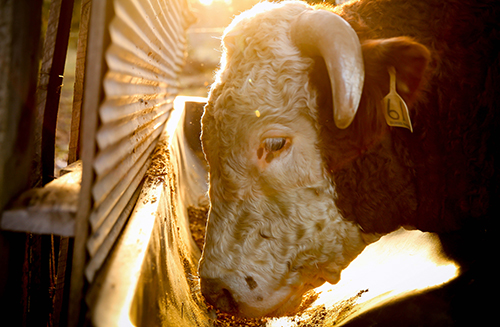Bull Feeding and Development
Mar 07, 2022

Developing beef herd bulls requires a substantial investment of time and money. During this period of development, bulls need to be fed properly to ensure long-term viability. There seem to be lots of witchcraft and voodoo promoted in the beef cattle world regarding feeding and developing bulls, mostly by those selling witchcraft and voodoo. Bull development need not be complicated if you understand a few basics.
Keep in mind the goal is a sound breeding bull with characteristics much like an athlete – fit and strong, mobile and flexible, not over-conditioned, with the ability to do lots of work and recover. Over-conditioned (fat) bulls lack libido and physical endurance and are more susceptible to heat stress during the summer months. Fat accumulation in the scrotum also serves as insulation, raising the temperature of the testicles and reducing sperm production.
Herd bulls are expected to breed all cows to which they are assigned in a limited timeframe. Doing so requires a bull to identify a cow in heat, tend her, and ultimately breed her, which can take several hours, and some cows will need to be bred more than once. Obviously, a breeding bull must be able to maintain a high level of activity.
Bulls must cover many more steps than a cow and are expected to do so over multiple seasons. Bulls typically weigh more than a cow and transfer their weight to the rear legs when breeding. Good skeletal structure and solid feet are a must. Sore-footed animals with bad hooves are not interested in breeding. A proper feeding program avoids high levels of starch and abrupt changes to prevent rumen acidosis and laminitis. Zinc methionine is a useful feed additive proven to aid hoof integrity.
Bulls primarily recognize signs of heat visually, with a sense of smell and pheromones secondarily. During development ensure nothing hinders the development of sight. Vitamin A and trace mineral nutrition must be adequate from conception forward. Prevent and promptly treat pink eye or any other health issues that could damage sight.
With those considerations in mind, there are essentially five developmental periods in a bull’s life, each with specific feeding objectives:
For more content like this, check out the latest issue of the Cooperator.
Keep in mind the goal is a sound breeding bull with characteristics much like an athlete – fit and strong, mobile and flexible, not over-conditioned, with the ability to do lots of work and recover. Over-conditioned (fat) bulls lack libido and physical endurance and are more susceptible to heat stress during the summer months. Fat accumulation in the scrotum also serves as insulation, raising the temperature of the testicles and reducing sperm production.
Herd bulls are expected to breed all cows to which they are assigned in a limited timeframe. Doing so requires a bull to identify a cow in heat, tend her, and ultimately breed her, which can take several hours, and some cows will need to be bred more than once. Obviously, a breeding bull must be able to maintain a high level of activity.
Bulls must cover many more steps than a cow and are expected to do so over multiple seasons. Bulls typically weigh more than a cow and transfer their weight to the rear legs when breeding. Good skeletal structure and solid feet are a must. Sore-footed animals with bad hooves are not interested in breeding. A proper feeding program avoids high levels of starch and abrupt changes to prevent rumen acidosis and laminitis. Zinc methionine is a useful feed additive proven to aid hoof integrity.
Bulls primarily recognize signs of heat visually, with a sense of smell and pheromones secondarily. During development ensure nothing hinders the development of sight. Vitamin A and trace mineral nutrition must be adequate from conception forward. Prevent and promptly treat pink eye or any other health issues that could damage sight.
With those considerations in mind, there are essentially five developmental periods in a bull’s life, each with specific feeding objectives:
- Pre-weaning – At birth mother’s milk is the sole source of nutrition and will be a significant contributor until weaning. This should be adequate unless some circumstance limits milk production, so creep feeding is typically not necessary.
- Post-weaning – Let them grow at their genetic potential, and this requires some groceries. Provide enough nutrition to allow rapid growth of frame and structure without fattening. This high plane of nutrition stimulates the onset of puberty and sperm producing cells. Ionophores and a limited amount of cereal grains can enhance this response.
- Conditioning – Time to step off the speeding train in preparation for the breeding season. Thirty to sixty days prior to breeding season transition to the same diet the cow herd will be on, sometimes referred to as “hardening off.” The goal here is a body condition score (BCS) of 5.5-6.5 so they have adequate energy reserves from which to draw.
- Breeding season – This is game day, time to perform. Bulls will be on the same nutrition program as the cow herd. Done right, that’s not a bad thing since the cows should be in a gaining condition for breeding. While doing his job he’s not eating and he’s not resting and can potentially lose a few hundred pounds.
- Post-breeding – Time to kick back and put up his feet. Bulls need to recover back to 5.5-6.5 BCS before he sees use again. This can usually be done with good forage and minerals; however, a supplemental feed may be needed if forage is lacking.
For more content like this, check out the latest issue of the Cooperator.